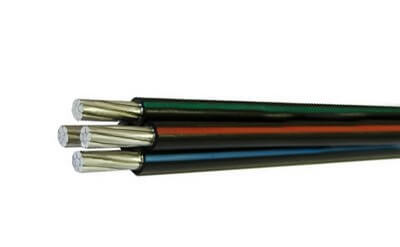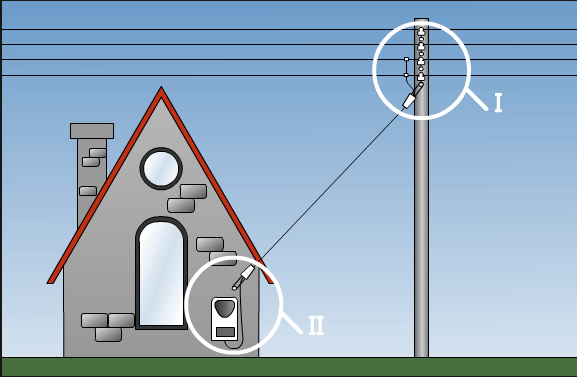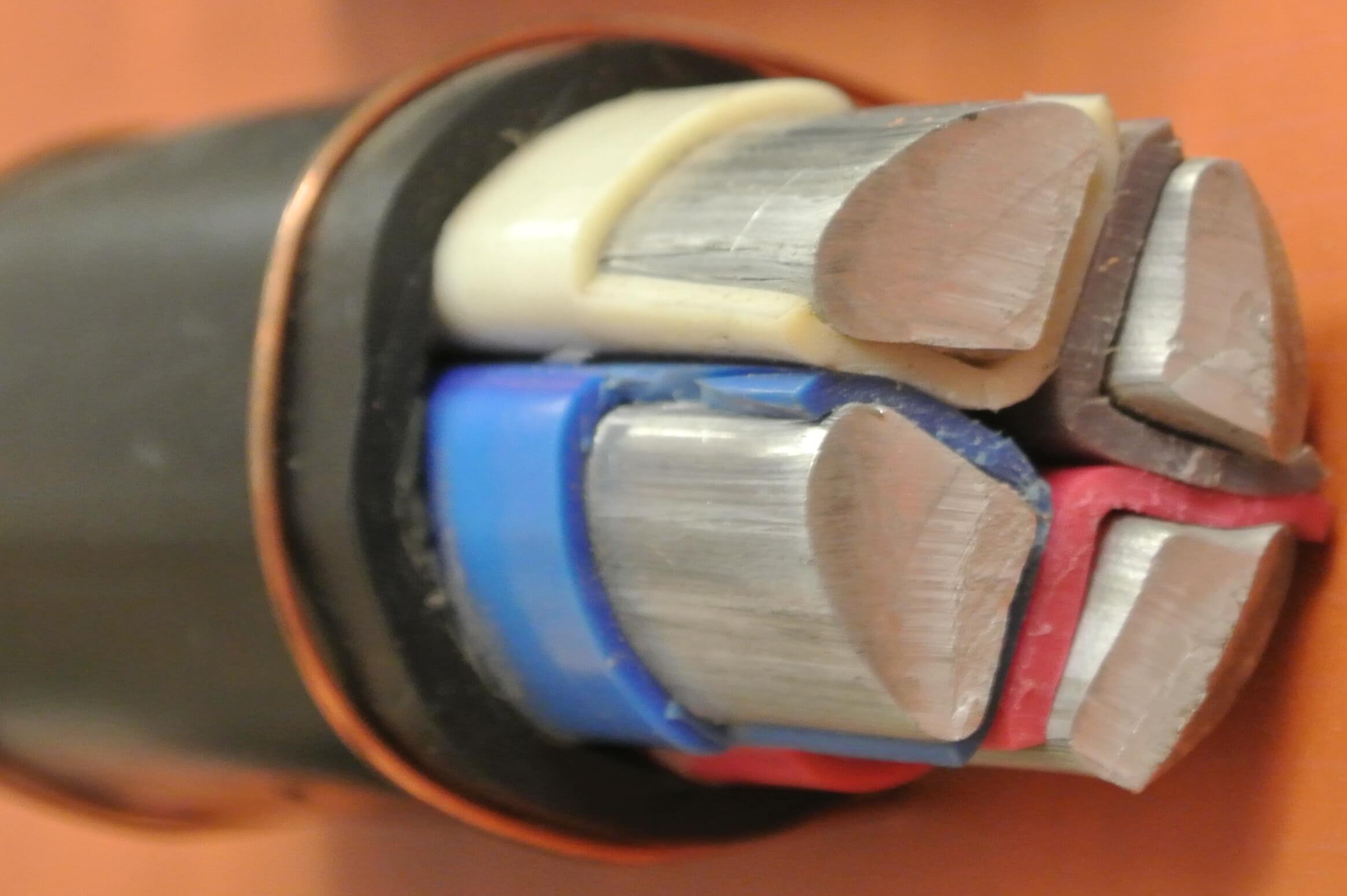Which cable is better to choose to connect the house to the mains?
By air
To connect the house to the mains by air, it is recommended to use the following cable brands:
AVK
This is a cable with aluminum conductors, vinyl insulation and coaxial braid. Designed for power transmission in networks up to 380 volts. Due to the design features, it is impossible to make an unauthorized connection to the power grid. AVK can be used for mounting input from the OHL section to the metering board. Operating temperature from -45 to +45 degrees. Suitable for connecting 220 volts, single phase and zero. Of the minuses of using this cable to connect to the house is the need to use a special coupling for electrical connection.
SIP-4
SIP stands forself-supporting insulated wire. This conductor is used for overhead power lines up to 1000 volts. The insulation is made of light stabilized cross-linked polyethylene. Operating temperature range from -60 to + 50 degrees. The wide range of sections and price range makes it an ideal candidate for connecting a house to the mains. The wire is suitable for connecting both single-phase consumers (220 volts) and three-phase (380 volts). Of the minuses, one can distinguish: the use of specialized couplings and the ambiguous attitude of inspectors of energy supply organizations to connecting this type of supply to the metering device. The fact is that the rules indicate that cable connections to the metering node are not permissible. The line should go in one piece, as shown in the image below:
Due to the specifics of SIP, it is not possible to bring into the metering board without making a transition to another, more flexible wire. Therefore, it is better to pre-coordinate this moment with the energy supply organization before you decide to choose a cable for connecting a private house to the network. About, how to connect SIP with a copper cable, we told in a separate article. Please note that according to chapter 1.7. PUE Section 1.7.131, the cross-section of CIP conductors must not be less than 16 mm².
AVVG
The decoding is as follows: aluminum, polyvinyl chloride insulation of conductors, polyvinyl chloride sheath, bare (no protective cover). Is used AVVG voltage up to 1 kV. Designed for use in temperate, cold and tropical climates. It is used for laying in air, wet and dry rooms, channels, trenches, partially flooded rooms with medium and strong corrosive activity. For aerial installation it is necessary to use cable wiring.The conductor is suitable for connecting consumers to the mains both 220 and 380 V.
VVG
VVG copper cable, PVC insulation of cores, PVC coating, without additional protection. Analogue AVVG in execution and characteristics, but with copper current-carrying conductors. It is used in networks up to 1000 volts. Climatic modification has a temperate and cold climate. It is also used for laying outdoors, dry and damp areas, in tunnels and wells, etc. For air wiring it is necessary to make cable wiring, the cable is used as a supporting element, and it is tied to it at regular intervals. You can find out how it is made from the article to which we referred. Please note that according to the same paragraph 1.7.131, the cross-section of copper cables in the branches must be at least 10 mm², and also that the insulation of VVG and AVVG cables is destroyed under the influence of ultraviolet radiation. Such cables, in addition to laying on the cable, it is better to additionally protect the polypropylene corrugationUV resistant.
Below are the tables for choosing a cable for connecting the house to the mains by air:
On how to draw a wire from a pillar to a house through the air, it is described in the video:
Underground
To lay the cable from the pillar to the house underground in the trench, these brands of conductors are most often used:
AVBBSHV
Designcable AVBBSHV includes aluminum conductors, PVC insulation of current-carrying conductors, armored coating, galvanized steel tapes and protective hose made of polyvinyl chloride. They are used for transmission and distribution of electricity in networks up to 3 thousand volts. It is made in a climatic modification of UHL and a tropical climate. Temperature range from -50 to +50 degrees. Its service life is 30 years.
This cable is not afraid of groundwater, not afraid of damage. The presence of a layer of armor makes it an excellent candidate for connecting the house to the power grid underground.Its full analogue, only with copper current-carrying conductors, is the VBBSHV brand.
VBBSHV
At VBBSHV copper conductors, insulation of current-carrying conductors is represented by PVC plastic, additionally, an armored coating and steel galvanized tapes, protected by a PVC hose, are provided. In addition to connecting country houses in an underground way, this cable is designed for outdoor installation on overpasses and galleries.
Below are the brands of cable for laying in trenches from a pillar to a house. All of them are summarized according to the operating parameters in a table, which allows you to choose the most suitable option for your conditions of connection to the mains.
Finally, we recommend that you look at how the wiring is carried out underground:
So we have provided the best brands of cable products in order to bring electricity to the input panel underground and by air. We hope the information made you understand which cable is needed to connect the house to the mains. We draw your attention to the fact that in this article we did not provide a section of veins. This is due to the fact that each consumer has its own permissible power indicated in the technical specifications (for example, 15, 25 or 30 kW). About, how to calculate the cable cross-section by power, we told in the corresponding article!
















Hello! Tell me, we have a cable supply from the pillar to the house underground. 25 meters. Electricity 15 kW 380. The cable is buried with aluminum section 4: 25. If you increase the power to 25 kW 380. Do I need to change the cable or is this enough? I really need an answer
Good evening, the 4 * 25 aluminum cable holds a load of 46kW.
So cable replacement is not required
Please tell me how to be.We decided to change the wiring to 380V, 15 kW, three phases. One electrician undertakes to do the wiring before entering the house, the other claims that this cannot be done. They say that it should be continuous until the machines. How right? What does it mean before entering the house?
There should be no gap connections to the opening (main) machine.
No one forbids making a cable break to the opening machine. You can tear in the shield on the input power terminals. This can make it easier to replace the lead-in machine if necessary. They will put a seal on the gap.
Need to stretch the cable from the shield to the house underground, which copper cable to choose? It is long 45 meters, 380v.
In the summer co-operative they are forced to change wires to SIP. Moreover, all wiring from the pillar should be outside the house and the input to the meter must be through the wall. Is this rightful?